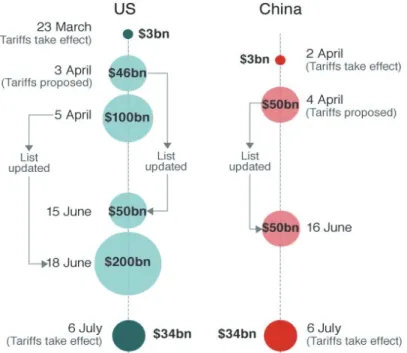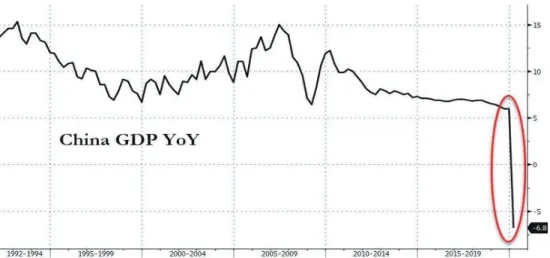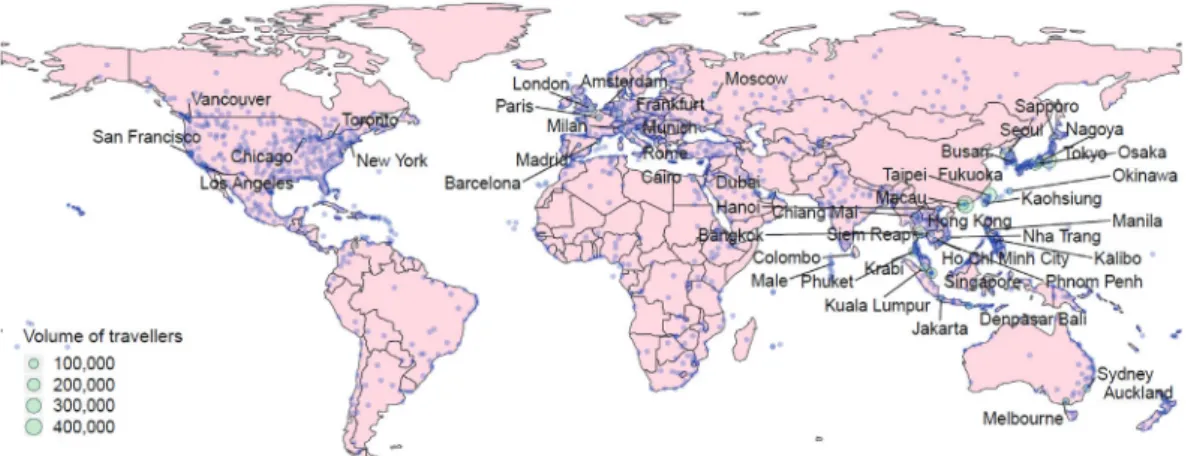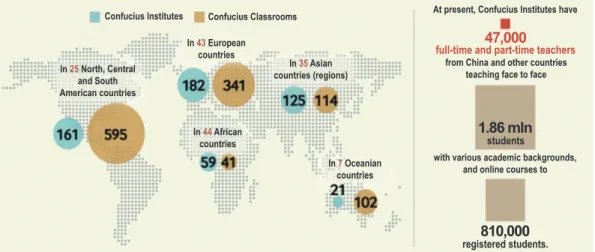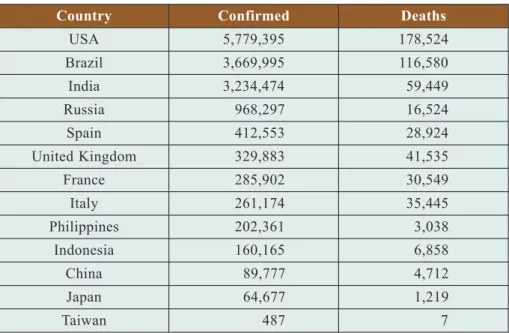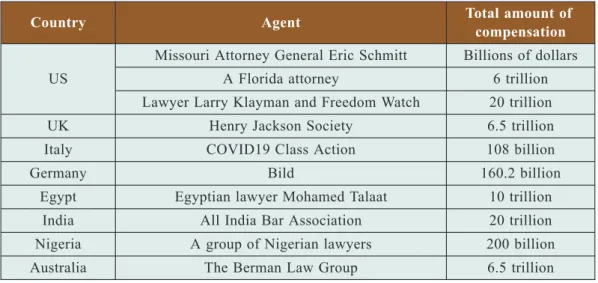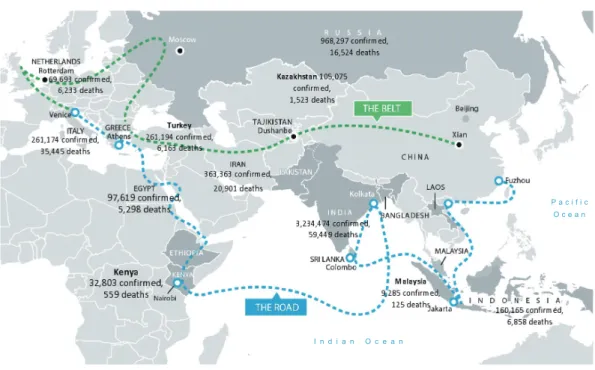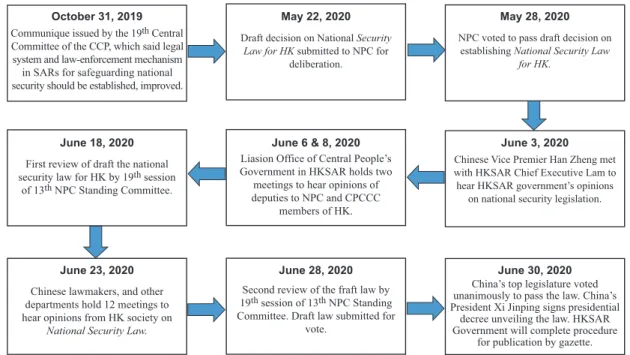An Analysis of the U.S.-China “New Cold War”
and COVID-19 on China’s International Image
Hseik-wen Soong
Professor, Institute of Strategic and International Affairs, National Chung Cheng UniversityAbstract
The COVID-19 has brought the U.S.-China standoff to the edge of unrestricted warfare. The U.S. has stressed that the pandemic has gone from being a simple domestic catastrophe in China to a major event that is changing human history. China, on the other hand, is covering up the pandemic and using the pandemic to expand its influence, holding live-fire drills in the South China Sea and even passing the Hong Kong National Security Law, intensifying its judicial persecution of Hong Kong pro-democracy activists, which has worsened U.S.-China relations. Along with the ever increasing toll of the confirmed cases and deaths from the pandemic, more and more countries in the world have decided to reduce their dependence on China, restructuring global industrial supply chains. In addition, COVID-19 exposes Chinese Communist Party’s “administrative efficiency”, which violated the principle of universal values of freedom, democracy and human rights. All of these events have posed critical challenge to China’s international image.
Keywords: COVID-19, U.S.-China Relations, U.S.-China New Cold War, China’s In-ternational Image, Unrestricted Warfare
I. Context of U.S.-China “New Cold War”
1. U.S.-China Relations Have Been Moving toward Comprehensive Competition since Trump Administration Took Office in 2017, and Has Been Evolving into a New Era of “New Cold War” between U.S. and China
On December 18, 2017, President Donald Trump published the National Security Strategy report under the “America First” theme of his presidency. The content directly
refers to “China and Russia challenge American power, influence, and interests, attempting to erode American security and prosperity.”1
On January 19, 2018, the U.S. Department of Defense released its National Defense Strategy Report, the first new national defense strategy in ten years. It emphasized “restoring America’s competitive military advantage to deter Russia and China from challenging the United States, its allies or seeking to overturn the international order that has served so well since the end of World War II.”2The report
once again emphasized that China and Russia as the greatest challenges to U.S. national security. China and Russia have surpassed the threat of terrorism as the top national security targets of the United States. The U.S. military will make significant strategic adjustments, diverting resources from the war on terror and launching a “major power military competition.”
Therefore, the relationship between the United States and China has entered into a new comprehensive competition since 2017. In fact, policy chief of Department of Defense had even directly named China as the greatest long-term threat to the United States.3Trump’s Secretary of State, Mike Pompeo, said in July, 2020, that China was
the biggest threat to the United States.4The United States is concerned about China’s
military expansion in the South China Sea, and its growing political and economic influence, as well as its cyber espionage activities against the United States.
The White House, The National Security Strategy of the United States of America (Washington: President of the U.S., 2017), p. 2, The White House, <https://www.whitehouse.gov/wp-content/ uploads/2017/12/NSS-Final-12-18-2017-0905.pdf>.
U.S. Department of Defense, The 2018 National Defense Strategy (Washington: Department of Defense, 2018), pp. 1-2, Department of Defense, <https://www.defense.gov/Portals/1/ Documents/pubs/2018-National-Defense-Strategy-Summary.pdf>.
Terri Moon Cronk, “China Poses Largest Long-Term Threat to U.S., DOD Policy Chief Says,” September 23, 2019, U.S. Department of Defense, <https://www.defense.gov/Explore/News/ Article/Article/1968704/china-poses-largest-long-term-threat-to-us-dod-policy-chief-says/>.
Michael R. Pompeo, “Communist China and the Free World’s Future,” July 23, 2020, U.S. Department of State, <https://www.state.gov/communist-china-and-the-free-worlds-future/>.
2. In 2018, Trump Launched a Tariff War against China in Response to the Growing U.S.-China Trade Deficit and a Hard-Hitting U.S.-China Agenda
On March 22, 2018, President Trump has announced plans to impose tariffs on up to $60bn of Chinese products for China’s theft of technology and trade secrets that has cost American companies billions of dollars in revenue and thousands of people lost jobs.5This set off the beginning of the US-China trade war (see Figure 1).
Figure 1. How the Tariff Battle Has Escalated in 2018
Source: Peterson Institute for International Economics, “Charting the US-China trade battle,” BBC, July 6, 2018, <https://www.bbc.com/news/business-44728166>.
In order to balance its trade deficit, the U.S. is asking China to make structural changes to its economy. The United States requires China to change its economic structure in five directions: 1. China’s long-term theft of U.S. intellectual property rights; 2. China compulsory technology transfer of U.S. enterprises in China; 3. China steals technology from other countries; 4. China’s subsidies to state-owned enterprises;
Mark Landler & Jim Tankersley, “Trump Hits China With Stiff Trade Measures,” New York Times, March 23, 2020, <https://www.nytimes.com/2018/03/22/us/politics/trump-will-hit-china-with-trade-measures-as-white-house-exempts-allies-from-tariffs.html?_ga=2.132232070.981845141. 1597236708-1837768353.1597062682>.
5. The Chinese government manipulates the RMB exchange rate. But for China, these demands are almost impossible to accept.
The escalation of the U.S.-China trade war has led to increased economic downturn pressure on China’s economy and sluggish growth of domestic consumption and investment. Chinese Premier Li Keqiang has said that China’s economic development environment in 2019 will face more difficulties and challenges, with the economic downturn pressure on the economy increasing.6As the debt crisis worsens, the stock
market, foreign exchange market, and real estate market are in danger of bubbles, and with increases in the number of unemployed, political and social stability in China will become a problem. In other words, even before the COVID-19 outbreak, the U.S.-China relationship had entered a stage of comprehensive competition as a result of the trade war. China’s economic development continues to slow down, presenting a serious economic downturn (see Figure 2) which has significantly affected the stock market, foreign exchange market and real estate market and the number of unemployed people continues to increase.
Figure 2. China’s GDP Plunged 6.8 Percent Year-on-Year in the First Quarter of 2020, the First Negative Reading on Record
Source: “[Recession] Shocking Data Revealed! China’s first quarter GDP plunges 6.8%! (with forecast figures and trend charts),” hket, April 17, 2020, <https://invest.hket.com/ article/2620026/>.
Li Keqiang, “Full Text: Report on the Work of the Government,” March 16, 2019, The State Council The People’s Republic of China, <http://english.www.gov.cn/premier/speeches/2019/03/16/ content_281476565265580.htm>.
II. Contents
1. Outbreak and Notification of COVID-19
(1) Origin of the COVID-19 Virus
President Trump and his colleagues are convinced that the coronavirus responsible for COVID-19 broke out in the fall of 2019 from P4 Labs in Wuhan, Hubei Province, China. From there, the coronavirus spread through the world. On April 30, 2020, Trump again claimed that the “Coronavirus came from Wuhan Virus Research Institute.”7On
May 3, 2020, Secretary of State Mike Pompeo claimed that there was “enormous evidence” that the virus had come from a Chinese lab in Wuhan.8Pompeo called on
the Chinese government to provide samples of the virus and access to it so that the U.S. could investigate whether the coronavirus came from a laboratory or a natural source.
(2) Notification of COVID-19 A. Notification from Taiwan
Taiwan Centers for Disease Control (CDC) wrote to World Health officials on December 31, 2019, asking for details about the Wuhan coronavirus pneumonia outbreak. The letter mentioned that the virus appeared to have characteristics of atypical pneumonia, and that the patients were being treated in an isolation room. Taiwan Central Epidemic Command Center (CECC) says that although it did not explicitly say in the email that “the epidemic will spread from human-to-human,” it did specifically mention the characteristics of atypical pneumonia and the patients in China were being treated in isolation rooms, clearly indicating the possibility of human-to-human transmission.9
Zachary Cohen, Alex Marquardt, Kylie Atwood, & Jim Acosta, “Trump contradicts US intel community by claiming he’s seen evidence coronavirus originated in Chinese lab,” CNN, May 1, 2020, <https://edition.cnn.com/2020/04/30/politics/trump-intelligence-community-china-coronavirus-origins/index.html>.
“Mike Pompeo: ‘enormous evidence’ coronavirus came from Chinese lab,” The Guardian, May 3, 2020, <https://www.theguardian.com/world/2020/may/03/mike-pompeo-donald-trump-coronavirus-chinese-laboratory>.
Taiwan CDC, “The facts regarding Taiwan’s email to alert WHO to possible danger of COVID-19,” April 11, 2020, Taiwan CDC, <https://www.cdc.gov.tw/En/Bulletin/Detail/PAD-lbwDHeN_bLa-viBOuw?typeid=158>.
B. WHO’s Response
The World Health Organization (WHO) has been accused of ignoring warnings from Taiwan that the virus could be transmitted human-to-human, following the outbreak of COVID-19 in China in late 2019. The WHO denies the claim and says that the emails sent by Taiwan made no mention of human-to-human transmission. The WHO said it received an email from Taiwan on December 31, 2019, referring to media reports of atypical pneumonia in Wuhan, which the Wuhan authorities believed was not a severe acute respiratory syndrome (SARS).10
C. Testimony of Chinese Virologists
In an interview with Fox News on July 10, Li-Meng Yan, a Chinese virologist, said that in the early days of COVID-19, Chinese authorities and the WHO covered up human-to-human transmission of the virus.11 More importantly, Yan revealed that
the source of COVID-19 is most likely to come from the artificial processing of a Chinese Communist Party military lab.12
2. The Impact of COVID-19 on China’s International Image and Foreign Affairs
(1) The COVID-19 Is Spreading around the World
In order to prevent COVID-19 from further spreading abroad, Chinese government began to impose strict “Wuhan lockdown” controls on January 23, 2020. But as many as five million people in Wuhan left before the lockdown, with a significant number traveling from Wuhan to all over the world. The “WorldPop” team at the University of Southampton (UK) simulated the movement of nearly 60,000 people before the Wuhan lockdown on January 23 using big data analysis. They were scattered to at least 382
“WHO denies ignoring Taiwan’s early coronavirus warning,” The Straits Times, April 10, 2020, <https://www.straitstimes.com/world/europe/who-denies-ignoring-taiwans-early-coronavirus-warning>. Barnini Chakraborty & Alex Diaz, “EXCLUSIVE: Chinese virologist accuses Beijing of coronavirus cover-up, flees Hong Kong: ‘I know how they treat whistleblowers,’” Fox News, July 10, 2020, <https://www.foxnews.com/world/chinese-virologist-coronavirus-cover-up-flee-hong-kong-whistleblower>.
Keoni Everington, “Chinese virologist claims coronavirus came from PLA lab,” Taiwan News, July 31, 2020, <https://www.taiwannews.com.tw/en/news/3977823>.
cities around the world, including Asia, Europe, the U.S. and Australia, which also meant that COVID-19 was feared to have been spread by these people everywhere (see Figure 3).13
Figure 3. Global Cities Receiving Airline Travellers from 18 High-Risk Cities in Mainland China Over Three Month Period
Source: University of Southampton, “Study analyzes potential global spread of new coronavirus,” January 28, 2020, EurekAlert, <https://www.eurekalert.org/pub_releases/2020-01/uos-sap012820.php#>.
On January 23, 2020, the WHO called another emergency meeting on COVID-19 but refused to declare a Public Health Emergency of International Concern (PHEIC).14
Tedros Adhanom Ghebreyesus, the director general of the WHO, said that COVID-19 is indeed an emergency in China, but it is not yet a global public health emergency. Since the WHO did not inform the world, no country in the world was able to take early action against COVID-19. In response to this, the Trump Administration believed that the WHO hid COVID-19 data in order to cooperate with China.
Shengjie Lai, Isaac Bogoch, Nick Ruktanonchai, Alexander Watts, Xin Lu, Weizhong Yang, Hongjie Yu, Kamran Khan, & Andrew J Tatem, “Assessing spread risk of Wuhan novel coronavirus within and beyond China, January-April 2020: a travel network-based modelling study,” March 9, 2020, MedRxiv, <https://doi.org/10.1101/2020.02.04.20020479>.
“Statement on the meeting of the International Health Regulations (2005) Emergency Committee regarding the outbreak of novel coronavirus (2019-nCoV),” January 23, 2020, WHO, <https:/ /www.who.int/news-room/detail/23-01-2020-statement-on-the-meeting-of-the-international- health-regulations-(2005)-emergency-committee-regarding-the-outbreak-of-novel-coronavirus-(2019-ncov)>.
(2) Countries in the World Do Not Understand That China Hid the Coronavirus Which Has Caused a Global Pandemic
According to the official data that China notified the WHO, countries around the world believed that China has three responsibilities: 1. the delay in reporting the spread of the coronavirus; 2. the concealment of the coronavirus; 3. the reported figures do not match the facts, so there is a problem of China covering up the coronavirus. When the COVID-19 broke out in Europe, the United States, Japan, Korea and other places, countries around the world had a great distrust of China and even anti-Chinese voices emerged.
(3) U.S.-China Unrestricted Warfare Exposed Many of China’s Failures to Prevent COVID-19 and Its Ambitions to Plunder International Resources In 1999, People’s Liberation Army (PLA) put forward a theory of “unrestricted warfare,” which means that “all forms other than force are used to force the opponent to accept Chinese interests.”15 This means that China intends to use all means, from
military, economic, diplomatic, scientific and technological, media to international organizations, to expand its own interests, such as the Confucius Institutes (culture), the Belt and Road Initiative (economic) and the Global Foreign Propaganda (media) strategies in recent years. And 5G equipment, a symbol of the future of cyber war, is also a very important means of unrestricted warfare.
On February 18, 2020, Trump claimed that the Chinese media does not report objectively and even cooperates with the Communist Party of China to demonize the United States and enflame racist tensions within the United States. As a result, the State Department told China that its five foremost news agencies—Xinhua, CGTN, China Radio, China Daily and The People’s Daily—will officially be treated as foreign government functionaries, subject to similar rules as diplomats stationed in the United States.16 China announced on February 19 that it would expel American journalists
working for The New York Times, The Wall Street Journal and The Washington Post.
喬良、王湘穗,《超限戰》(武漢:崇文書局, 1999 年), pp. 1-4.
“U.S. Designates China’s Official Media as Operatives of the Communist State,” New York Times, February 18, 2020, <https://www.nytimes.com/2020/02/18/world/asia/china-media-trump. html>.
It also demanded that those outlets, as well as the Voice of America and Time magazine, provide the Chinese government with detailed information about their operations.17
In addition, the United States has responded to China’s frequent theft of technology and intellectual property from other countries. For example, Huawei has completed its deployment of global markets, specifications and cost competition. In particular, the embrace of Huawei by European countries has become a threat to U.S. attempts to contain Huawei. The U.S. government is therefore making a national effort to build a “U.S. version of 5G” in order to block the global spread of the “Chinese version of 5G” represented by Huawei.
At the same time, China is promoting “A Thousand Talents.” This is a high-profile program to bring in senior overseas talent to China for innovation and entrepreneurship. However, the Federal Bureau of Investigation (FBI) considers the Thousand Talents as a part of “China’s non-traditional intelligence efforts against the United States” and a priority for the U.S. in pursuing the theft of intellectual property rights and the endangering of national security. In September 2018, the FBI prioritized Thousand Talents scholars for investigation, and the U.S. looked at participants by name.18The U.S. believes that this is a means for China to steal intellectual property
and important technology. In the last two years, a number of Chinese scientists have been arrested in the United States for espionage and on other charges.
As for the Confucius Institutes, they are considered to be a global network of language and cultural centers affiliated with the Chinese government (see Figure 4). In recent years, a growing number of scholars in the United States and Europe have expressed concerns that Confucius Institutes around the world closely reflect the Communist Party’s ideology. Confucius Institutes have been accused of human rights violations, bribery, information surveillance, theft of host country secrets, and espionage. Nowadays, university campuses in Europe and the United States have raised concerns about the potential risks of Confucius Institutes’ increased censorship, interference
“China Announces That It Will Expel American Journalists,” New York Times, March 18, 2020, <https://www.nytimes.com/2020/03/17/business/media/china-expels-american-journalists.html>. “Panic over US scrutiny of science talent programme,” University World News, October 18, 2018, <https://www.universityworldnews.com/post.php?story=20181018183445307>.
with academic freedom, and possible theft of proprietary research results from university campuses.19 In 25 North, Central and South American countries In 43 European countries In 35 Asian countries (regions) In 44 African countries In 7 Oceanian countries
At present, Confucius Institutes have
full-time and part-time teachers
Confucius Institutes Confucius Classrooms
from China and other countries teaching face to face
with various academic backgrounds, and online courses to
1.86 mln
students
registered students.810,000
47,000
Figure 4. Confucius Institutes around the World
Source: “8 more countries set up Confucius institutes or classrooms in 2019,” UNB News, December 12, 2019, <https://www.unb.com.bd/category/World/8-more-countries-set-up-confucius-institutes-or-classrooms-in-2019/37912>.
The COVID-19 outbreak has raised the U.S.-China standoff to the edge of unrestricted warfare. The virus, originating in Wuhan, China, has radically altered the world situation that had been seemingly settled through the U.S.-China trade war. The Trump administration has stressed that the pandemic has gone from being a simple domestic catastrophe in China to a major event that is changing human history. China is trying to use the pandemic to reinforce its goal of world hegemony.
(4) China Is Taking Advantage of the Pandemic to Expand Its Military in the Western Pacific
After the outbreak of the pandemic, the United States had four aircraft carriers deployed in the Indo-Pacific—the USS Roosevelt, USS Ronald Reagan, USS Carl Vinson and USS Nimitz—infected.20 Due to the uncertainty of the situation within
the U.S. military, U.S. Defense Secretary Mark Esper ordered a 60-day suspension
Robert Burton-Bradley, “China’s Confucius Institutes have spy agencies and governments increasingly alarmed,” ABC News, March 10, 2019, <https://www.abc.net.au/news/2019-03-10/ confucius-influence-around-the-world-in-question/10875960>.
of troop movements and travel, and announced the suspension of large-scale training and exercises. After the outbreak of COVID-19, China held live-fire military drills in the South China Sea in March and April, 2020, to imitate the invasion of Western Pacific countries. It shows that the PLA could take advantage of the situation while countries are busy with the pandemic, causing instability and threats in the region. It also aroused the anxiety and resentment of Asia-Pacific countries toward China, and further accelerated the U.S.-China “New Cold War.”
(5) Blame China and Demand Compensation from China
As of August 26, 2020, COVID-19 has caused 820,209 deaths and 23,926,683 confirmed cases worldwide.21 China’s concealment of COVID-19 has contributed to
the worldwide pandemic (see Table 1).
Table 1. Selected Pandemic Statistics by Country
Country Confirmed Deaths
USA 5,779,395 178,524 Brazil 3,669,995 116,580 India 3,234,474 59,449 Russia 968,297 16,524 Spain 412,553 28,924 United Kingdom 329,883 41,535 France 285,902 30,549 Italy 261,174 35,445 Philippines 202,361 3,038 Indonesia 160,165 6,858 China 89,777 4,712 Japan 64,677 1,219 Taiwan 487 7
Source: “Latest figures on China’s coronavirus outbreak,” Taiwan News, August 26, 2020, Accessed, <https://www.taiwannews.com.tw/en/news/3864928>.
“Sailor aboard 4th U.S. aircraft carrier tests positive for coronavirus,” POLITICO, April 7, 2020, <https://www.politico.com/news/2020/04/07/coronavirus-sailor-aircraft-carrier-navy-nimitz-173210>. Johns Hopkins University & Medicine Coronavirus Resource Center, “Global Cases and Global Deaths,” August 26, 2020, Accessed, JHU, <https://coronavirus.jhu.edu/map.html>.
Many countries, such as the United States, Australia, UK, Italy, Germany, Nigeria, Egypt and India, have decided to demand compensation from China for COVID-19. The amount of compensation may exceed US$50 trillion (see Table 2).
Table 2. 8 Countries Demand Compensation from China for COVID-19. (Unit: US Dollars)
Country Agent Total amount of
compensation US
Missouri Attorney General Eric Schmitt Billions of dollars
A Florida attorney 6 trillion
Lawyer Larry Klayman and Freedom Watch 20 trillion
UK Henry Jackson Society 6.5 trillion
Italy COVID19 Class Action 108 billion
Germany Bild 160.2 billion
Egypt Egyptian lawyer Mohamed Talaat 10 trillion
India All India Bar Association 20 trillion
Nigeria A group of Nigerian lawyers 200 billion
Australia The Berman Law Group 6.5 trillion
Source: 小山,〈世界現有 8 國向中國索疫情賠償 775 萬億 北京怒斥〉, rfi, April, 29, 2020, <https://www.rfi.fr/tw/中國/20200429-世界現有 8 國向中國索疫情賠償 775 萬億-北京 怒斥>.
U.S. President Trump said the U.S. is investigating China’s failure to stop the spread of COVID-19. He would hold China accountable and demand compensation. Eric Schmitt, Missouri’s attorney General, and Lynn Fitch, Mississippi’s Attorney General, accused China of concealing COVID-19 outbreak, causing loss of U.S. lives and economic losses, and demanded compensation from China.22 In addition, U.S.
Republican Senators Marsha Blackburn and Martha McSally would introduce the Stop China-Originated Viral Infectious Diseases (COVID) Act.23 Republican Senator Josh
Hawley introduced the Justice for Victims of COVID-19 Act to pursue China’s handling
Kathryn Watson, “Missouri and Mississippi sue China over coronavirus,” CBS NEWS, April 22, 2020, <https://www.cbsnews.com/news/missouri-sues-china-over-coronavirus/>.
“McSally & Blackburn to Introduce the Stop COVID Act to Hold China Accountable for the Spread of the Coronavirus,” Martha McSally Newsroom, April 20, 2020, <https://www.mcsally. senate.gov/news/press-releases/mcsally-and-blackburn-to-introduce-the-stop-covid-act-to-hold-china-accountable-for-the-spread-of-the-coronavirus>.
of the coronavirus outbreak and seek compensation from the Chinese government.24
(6) The Belt and Road Initiative and COVID-19.
Since 2013, China has adopted “The Belt and Road Initiative (B&R)” as the main axis of its foreign and trade policy, which is a large-scale external lending program covering both land and maritime infrastructure. The B&R is undoubtedly the largest infrastructure and investment project in history, with around 70 countries participating. After China promoted B&R, exchanges between China and third-world countries have intensified. From the perspective of the possibility of the spread of COVID-19, it is critical that it spread with the arrival of Chinese engineers in the development of infrastructure in these countries (see Figure 5).
I n d i a n O c e a n
P a c i f i c O c e a n
Figure 5. “One Belt and One Road” Became “One Belt and Epidemic Road”
Source: “Beware Of China’s One Belt, One Road,” MEKONGEYE, October 21, 2017, <https:// www.mekongeye.com/2017/10/21/beware-of-chinas-one-belt-one-road/>;Johns Hopkins University & Medicine Coronavirus Resource Center, “Global Cases and Global Deaths.”
USA Congress, “S.3588 - Justice for Victims of Coronavirus Act,” May 4, 2020, 116th Congress, <https://www.congress.gov/bill/116th-congress/senate-bill/3588>.
African countries have borrowed billions from China while China developed the B&R. But with the outbreak of COVID-19, these countries that had borrowed from China suffered severe economic shocks. This has led to calls from these countries for China to provide debt relief or forgiveness. On June 17, 2020, Chinese President Xi Jinping announced that within the Forum on China-Africa Cooperation (FOCAC) frame-work, China will cancel the debt of relevant African countries in the form of interest-free government loans that are due to mature by the end of 2020, including further ex-tending the period of debt suspension, to help tide them over the current difficulty.25
(7) Human Rights Issues—The Hong Kong National Security Law
The Hong Kong National Security Law was passed by the National People’s Congress (NPC) on June 30, 2020,26 which shook the principles of “one country, two systems,”
“Hong Kong people ruling Hong Kong,” and the Hong Kong Basic Law. Once the “Hong Kong National Security Law” conflicts with other laws of Hong Kong, the Hong Kong National Security Law will take precedence. This has raised concerns that the human rights, freedom of speech and Hong Kong autonomy protected by the Basic Law cannot be the reason for the defense of those accused of endangering national security.
The Hong Kong National Security Law has drawn international criticism. The Five Eyes Alliance (formed by the United States, UK, Australia, Canada, and New Zealand), and Japan have strongly expressed their opposition to the law. The U.S. Senate and House passed the Hong Kong Human Rights and Democracy Act, which compels the government to support Hong Kong pro-democracy activists by requiring it to impose sanctions on Chinese and Hong Kong officials responsible for human rights abuses in the territory.27 In response, the CCP has also attempted to intensify
its judicial persecution of Hong Kong pro-democracy activists, which has further worsened U.S.-China relations.
Ministry of Foreign Affairs of the People’s Republic of China, “Joint Statement of the Extraordinary China-Africa Summit On Solidarity Against COVID-19,” June 17, 2020, Ministry of Foreign Affairs of the People’s Republic of China, <https://www.fmprc.gov.cn/mfa_eng/zxxx_662805/t1789596.shtml>. Helen Regan, “China passes sweeping Hong Kong national security law,” CNN, June 30, 2020, <https://edition.cnn.com/2020/06/29/china/hong-kong-national-security-law-passed-intl-hnk/ index.html>.
“Hong Kong: US passes sanctions as nations condemn new law,” BBC NEWS, July 2, 2020, <https://www.bbc.com/news/world-asia-china-53259656>.
The U.S. Congress took concrete action to support Taiwan as the Hong Kong National Security Law would be implemented in Hong Kong. U.S. Republican Senator Josh Hawley introduced the Taiwan Defense Act (TDA), which would ensure that the United States is able to continue meeting its obligations under the Taiwan Relations Act, to prevent China’s strategy of imposing a “fait accompli” on Taiwan and to report regularly to Congress on this progress.28 Rep. Mike Gallagher introduced the same
bill in the House of Representatives on July 1, 2020, to ensure that the United States is able to continue to meet its obligations under the Taiwan Relations Act in the face of the Chinese Communist Party’s aggressive military build-up, maintaining the ability to defeat a Chinese invasion against Taiwan that would result in a fait accompli. “Taiwan’s liberty is a vital national security interest of the United States, and the TDA helps ensure our military has the capabilities it needs to block CCP aggression.”29
October 31, 2019 Communique issued by the 19th Central
Committee of the CCP, which said legal system and law-enforcement mechanism in SARs for safeguarding national security should be established, improved.
May 22, 2020 Draft decision on National Security
Law for HK submitted to NPC for
deliberation.
May 28, 2020 NPC voted to pass draft decision on
establishing National Security Law
for HK.
June 3, 2020 Chinese Vice Premier Han Zheng met with HKSAR Chief Executive Lam to hear HKSAR government’s opinions
on national security legislation. June 6 & 8, 2020
Liasion Office of Central People’s Government in HKSAR holds two
meetings to hear opinions of deputies to NPC and CPCCC
members of HK. June 18, 2020
First review of draft the national security law for HK by 19th session
of 13th NPC Standing Committee.
June 23, 2020 Chinese lawmakers, and other departments hold 12 meetings to hear opinions from HK society on
National Security Law.
June 28, 2020 Second review of the fraft law by 19th session of 13th NPC Standing
Committee. Draft law submitted for vote.
June 30, 2020 China’s top legislature voted unanimously to pass the law. China’s President Xi Jinping signs presidential
decree unveiling the law. HKSAR Government will complete procedure
for publication by gazette.
Figure 6. Timeline of National Security Law for Hong Kong
Source: “Timeline of National Security Law for Hong Kong,” Global Times, June 30, 2020, <https://www.globaltimes.cn/content/1193126.shtml>.
Josh Hawley Newsroom, “Senator Hawley Introduces Taiwan Defense Act,” June 11, 2020, Josh Hawley Newsroom, <https://www.hawley.senate.gov/senator-hawley-introduces-taiwan-defense-act>. Mike Gallagher Newsroom, “Gallagher Introduces Taiwan Defense Act,” July 1, 2020, Mike Gallagher Newsroom, <https://gallagher.house.gov/media/press-releases/gallagher-introduces-taiwan-defense-act>.
III. Implications
1. Global Industrial Supply Chain Restructuring
In the past, the world’s economy was dependent on China. As a result of the coronavirus pandemic, the global industrial supply chain has been cut off and governments are beginning to think about restructuring the supply chain of global industries. Japan has set aside $2.2 billion to help companies shift production out of China. European trade ministers have emphasized the need to diversify supply chains. Several countries, including Australia and Germany, have moved to keep China, among others, from buying businesses weakened by lockdowns.30
The COVID-19 pandemic in the United States has caused enormous economic damage and loss of life. This has prompted the U.S. government to make a determined effort to change the U.S.’s over-reliance on China for production and supply chains. The U.S. wants to shift its supply chains to more friendly countries. The United States is pushing to create an alliance of “trusted partners” dubbed the “Economic Prosperity Network.” It would include companies and civil society groups operating under the same set of standards on everything from digital business, energy and infrastructure to research, trade, education and commerce.31 The U.S. government is working with
Australia, India, Japan, New Zealand, South Korea and Vietnam to “move the global economy forward,” Secretary of State Mike Pompeo said April 29.32
Damien Cave, Motoko Rich, & Jack Ewing, “Break the China Habit? Lobsters, Lights and Toilets Show How Hard It Is,” New York Times, June 15, 2020, <https://www.nytimes. com/2020/06/15/business/china-decoupling.html?_ga=2.110497734.2122906352.1597062682-1837768353.1597062682>.
Humeyra Pamuk & Andrea Shalal, “Trump administration pushing to rip global supply chains from China: officials,” REUTERS, May 4, 2020, <https://www.reuters.com/article/us-health- coronavirus-usa-china/trump-administration-pushing-to-rip-global-supply-chains-from-china-officials-idUSKBN22G0BZ>.
Michael R. Pompeo Press Briefing Room, “Secretary Michael R. Pompeo At a Press Availability,” April 29, 2020, U.S. Department of State, <https://www.state.gov/secretary-michael-r-pompeo-at-a-press-availability-4/>.
2. COVID-19 Exposes the Blind Spot of the Chinese Communist Party’s “Administrative Efficiency” — Violating the Principle of Universal Values of Freedom, Democracy and Human Rights
In the early days of COVID-19 outbreak, the Chinese government came under widespread criticism for its tough measures such as lockdown and stay-at-home orders. When COVID-19 hit the world, Europe and the U.S. were caught up in the pandemic partly because of missed opportunities to prevent the disease at an early stage. In con-trast, China’s initial mass lockdown and strict population movement began to have an initial effect in March. Compared with the rapid and strict control in China and the delayed and loose control in Europe and the United States, some argue that the authoritarian system is more effective in responding to COVID-19 crisis. China did not miss the opportunity to trumpet its rapid containment of the pandemic due to the authoritarian leadership of one-party dictatorship that follows the “Xi Jinping Thought on Socialism with Chinese Characteristics for a New Era.”33
However, the methods used by China to control the spread of COVID-19, such as the lockdown, are inhumane and in violation of human rights. Instead, the COVID-19 highlights that China was quickly and effectively able to bring the coronavirus under control in March, and the administrative efficiency of its authoritarian regime, comes at the expense of democracy and human rights. Therefore, in the COVID-19 outbreak, the “Xi Jinping Thought on Socialism with Chinese Characteristics for a New Era” advocated by China does not have any institutionalized supervision. Instead, it relies on the personal ideas, values and interests of the party secretary or a minority of leaders to handle all policies. Rather, it highlights the incompatibility of the Chinese system with the Western system. In other words, the Chinese system would be a great threat to humanity.
China is not a democratic country, without the spirit and system of justice and human rights. Compared to China, Western countries have open access to data, judicial authorities that can investigate medical negligence, and the administrative system has
楊勝群,〈始終堅持以人民為中心的根本立場(深入學習貫徹習近平新時代中國特色社會 主義思想)〉,《人民日報》, June 3, 2020, <http://www.dswxyjy.org.cn/BIG5/n1/2020/0603/ c423712-31733307.html>.
a national compensation system, but China does not. China’s rules of engagement are based on the personal opinions and words of its party secretaries. This is in sharp contrast to Taiwan’s emphasis on freedom, democracy and human rights, as well as its excellent treatment of epidemic prevention. Countries around the world have given higher support and affirmation to Taiwan’s democracy and epidemic prevention.
Xi Jinping faces many domestic economic, social and political problems in maintaining stability arising from the U.S.-China trade and technology wars. Thus the CCP has taken more aggressive military measures in the Taiwan Strait and the South China Sea in order to shift the focus of its internal problems. This has drawn the attention of the United States, Japan, India, Australia and other countries, and has led to live-fire military drills in the Indo-Pacific region in June, July and August. For example, the United States and Japan conducted joint naval exercises in the South China Sea on June 23.34From July 19 to 23, the U.S., Japan and Australia conducted
joint naval exercises in the South China Sea and the Western Pacific,35 and the U.S.
and Indian navies also conducted a joint exercise, in the Eastern Indian Ocean, on July 20.36The radical deterioration of U.S.-China relations has made a military conflict
between the U.S. and China in the Taiwan Strait and the South China Sea more possible, and has caused instability in the Indo-Pacific region. This is entwined with the COVID-19 pandemic, U.S.-China competition and Indo-Pacific regional security, which has the potential to deliver the most uncertainty in international relations since the end of the Cold War.
Lt. Lauren Chatmas, “U.S. Navy, JMSDF exercise together in South China Sea,” June 24, 2020, U.S. Indo-Pacific Command, <https://www.pacom.mil/Media/News/News-Article-View/ Article/2231439/us-navy-jmsdf-exercise-together-in-south-china-sea/>.
“Ronald Reagan CSG Begins Trilateral Naval Exercise with Australia, Japan in Philippine Sea,” DEF POST, July 21, 2020, <https://defpost.com/ronald-reagan-csg-begins-trilateral-naval-exercise-with-australia-japan-in-philippine-sea/>.
“Message to China: India, US conduct naval drill amid LAC standoff,” The New Indian Express, July 21, 2020, <https://www.newindianexpress.com/nation/2020/jul/21/message-to-china-india-us-conduct-naval-drill-amid-lac-standoff-2172613.html>.
